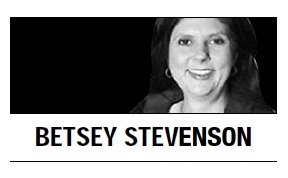
It’s easy to get the impression, as the US celebrated the 45th annual Women’s Equality Day on Sunday that the march toward equality has slowed to a crawl. Allow me to disagree.
True, the usual statistics tell a story of stalled progress. Women’s labor force participation stands at less than 57 percent, down from a peak of 60 percent in the late 1990s. The rapid improvements in the gender wage gap that occurred in the 1980s and early 1990s show little sign of returning. And mothers — particularly the large number who are single — still shoulder most of the burden of child-rearing.
A deeper look, however, suggests more fundamental change in women’s experiences as equals at home and in the workplace.
Despite slow progress in earnings on average, more women are out-earning their husbands. Men, for their part, are increasingly recognizing the importance of making a contribution at home: They are now more likely than women to say that work is interfering with their family life, and are increasingly seeking out employers that offer paternity leave and workplace flexibility.
Although stay-at-home dads and breadwinner wives are still minorities, their growing presence is changing people’s expectations about the appropriate roles for men and women. Fewer people of both genders believe that it’s better for a man to work and a woman to tend the home, or that having a working mom somehow hurts children.
In the workplace, women are more likely to be in positions of leadership. They are now the majority of workers in management, professional and related occupations — which shouldn’t come as a surprise, given their dominance in higher education. Glass ceilings are breaking, and not only in the presidential race: In 2015, 28 percent of all CEOs were women, up from 23 percent in 2008. Females own 38 percent of all businesses, compared to 29 percent in 2007.
Socially, men and women are becoming more aware of gender bias, a crucial step toward making it less prevalent. As of 2014, roughly 4 in 5 women agreed that an equally qualified woman would be passed over for a promotion in favor of a man, up from just 1 in 2 in 2006. And the tide in attitudes keeps turning: A more recent poll found that the majority of younger respondents believe that women make better managers.
Changing attitudes are translating into better behavior. For instance, fewer women are reporting sexism or being sexually harassed at work compared with a decade ago. When harassment does occur, women are better equipped to speak out. In 1991, when Anita Hill accused Supreme Court nominee Clarence Thomas of harassment, she was ridiculed and he was defended. In the past couple years, similar harassment cases have led to the ouster of Roger Ailes at Fox News and faculty members at Caltech and Berkeley. It’s still extremely costly for women to confront their advisers, mentors and managers, but today their actions are more likely to lead to change.
To be sure, there’s still much more to be done. Legislating paid family leave would help bring US government policy more in line with a changing society — and with other developed nations. The US Congress also needs to pass the Paycheck Fairness Act, which prohibits employers from penalizing workers who inquire about, discuss or disclose their compensation.
Businesses, for their part, must adapt to the needs of their workers, which means instituting more family-friendly policies and making a concerted effort to reduce the pay gap. This goes beyond ensuring equal pay for equal work. Companies must seek to eliminate more subtle barriers that reduce the likelihood that a highly qualified woman or minority is hired, promoted or given a deserved raise — a goal that a consortium called Employers for Pay Equity has come together to pursue. The more businesses do to find and share solutions, the more they and the broader economy will benefit.
By Betsey Stevenson
Betsey Stevenson is a Bloomberg View columnist. She is an associate professor of public policy and economics at the University of Michigan. She was on the President’s Council of Economic Advisers and was chief economist at the US Department of Labor. — Ed.








![[Weekender] Korea's traditional sauce culture gains global recognition](http://res.heraldm.com/phpwas/restmb_idxmake.php?idx=644&simg=/content/image/2024/11/21/20241121050153_0.jpg)